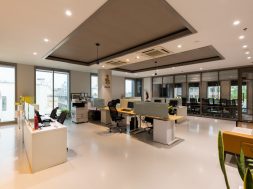BMUs take centre stage in building lifecycle management

Throughout my 22-year architectural career, I’ve seen firsthand the development of our urban skylines—and, more importantly, the evolution of how we preserve them. Building Maintenance Units (BMUs), which were previously limited to simple façade access devices, now play an increasingly crucial role in building lifecycle management. Today’s BMUs range from permanently installed roof-mounted systems with telescopic or articulated arms to track-based gantries and transportable davit systems, each designed to meet the structure’s specific geometric and functional requirements. Their adaptability is now matched by intelligence as technology reshapes maintenance and repair to prioritise efficiency, precision, and sustainability.
Tech-enabled structural inspection for precision
Modern BMUs are becoming increasingly integrated with modern imaging technologies, including LiDAR (Light Detection and Ranging), heat sensors, and high-resolution visual scanners. These instruments automate structural checks and provide complete façade assessments without the need for scaffolding or intrusive access. As a result, diagnostic accuracy improves, degradation is detected earlier, and repair plans are more effective. In a profession that requires accuracy, these technologies improve inspection dependability to levels that manual techniques cannot match.
Drones: Agile eyes in the sky
The emergence of drone technology has revolutionised external building diagnostics. Drones coupled with thermal cameras and AI-powered analysis software can quickly detect fractures, leaks, and insulation breaches. Especially in regions that humans find difficult or dangerous to access, UAVs’ agility enables comprehensive examinations in a fraction of the time that traditional methods would take, promoting proactive maintenance and safety compliance in high-rise and large-span structures; for example, KTV Working Drones and Burooj Air.
AR/VR: Empowering technicians with remote intelligence
Augmented and Virtual Reality (AR/VR) are transforming the way experts apply their knowledge in challenging repair situations. On-site technicians can now receive real-time remote support, with augmented reality overlays directing them through concealed services, structural layouts, and system schematics. This reduces errors, accelerates repairs, and closes the gap between design intent and on-site execution, which is crucial in heritage restorations and technologically connected buildings.

Smart building management systems (BMSs)
Contemporary Building Management Systems (BMSs) serve as the nervous system of intelligent buildings, in addition to making buildings operationally efficient. These systems integrate real-time data from HVAC, lighting, access control, and building management units (BMUs), allowing for predictive maintenance and informed resource management. As architects, our responsibility extends beyond design to ensure the building’s long-term health. Smart BMS platforms enable the continual optimisation of performance and energy consumption.
IoT and analytics for infrastructure integrity
In infrastructure projects, particularly bridges and large-scale public constructions, IoT sensors embedded in critical components provide continuous data on stress, temperature, and load. These systems, which have been augmented with analytics and AI, can detect anomalies in real-time and intervene predictably. BMUs have a dual role in this scenario, serving not just as maintenance access but also as mobile platforms for sensor deployment and monitoring in otherwise inaccessible areas.
Modern Building Management Units (BMUs) are more than just access points; they are essential components of a building’s maintenance ecosystem. When combined with developing technology, BMUs help to create safer, smarter, and more sustainable structures. For those of us who value long-term architectural integrity, adopting these improvements is not only progressive but also necessary.
For more details, visit: https://www.godrejconstruction.in/
Cookie Consent
We use cookies to personalize your experience. By continuing to visit this website you agree to our Terms & Conditions, Privacy Policy and Cookie Policy.










